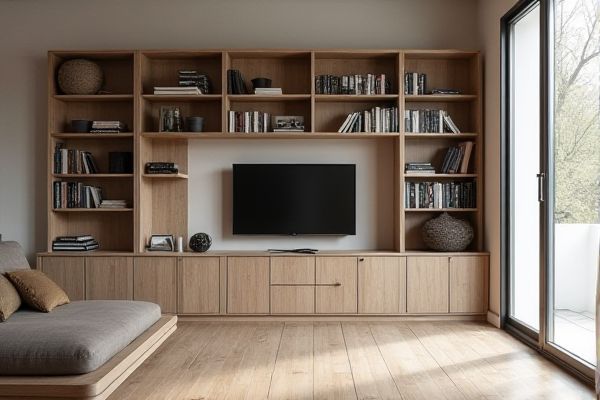
Freestanding bookcases offer flexibility in placement and easy relocation, while wall-mounted bookcases save floor space and provide a sleek, modern look. Explore the full comparison to discover which option best suits Your space and storage needs.
Table of Comparison
| Feature | Freestanding Bookcase | Wall-Mounted Bookcase |
|---|---|---|
| Installation | No drilling required; easy to move. | Requires drilling; fixed installation. |
| Space Usage | Occupies floor space. | Saves floor space; mounted on wall. |
| Weight Capacity | Generally higher load capacity. | Limited by wall strength and mounting hardware. |
| Mobility | Portable and easy to relocate. | Permanent; not easily moved. |
| Design Options | Wide variety of sizes and styles. | Modern, sleek designs; minimalist look. |
| Cost | Typically more affordable. | Often more expensive due to installation. |
| Cleaning | Requires floor cleaning under unit. | Easier to clean floor beneath. |
| Safety | Risk of tipping; may need anchoring for stability. | Securely attached; less tipping risk. |
Introduction: Freestanding vs Wall-Mounted Bookcases
Freestanding bookcases offer versatile placement options with ample storage capacity and ease of relocation, making them ideal for flexible room arrangements. Wall-mounted bookcases save floor space and create a sleek, modern look by securely attaching to walls, perfect for smaller rooms or contemporary interiors. Choosing the right option depends on your space availability, aesthetic preference, and storage needs.
Design and Aesthetic Differences
Freestanding bookcases offer versatile design options with a variety of sizes, materials, and styles that can serve as statement pieces or complement existing decor. Wall-mounted bookcases provide a sleek, minimalist aesthetic that maximizes floor space while creating a floating effect, often enhancing modern and contemporary interiors. The choice between the two depends on spatial constraints and desired visual impact, with freestanding units adding bulk and permanence, and wall-mounted shelves delivering a streamlined, open look.
Space Efficiency and Room Placement
Freestanding bookcases offer flexible room placement and can be easily repositioned, making them ideal for larger spaces or changing layouts. Wall-mounted bookcases maximize space efficiency by utilizing vertical wall area, freeing up floor space and enhancing room flow in smaller rooms. Your choice depends on how much floor space you want to conserve and the adaptability needed for your room's design.
Installation Requirements and Ease
Freestanding bookcases require minimal installation, often needing only simple assembly with basic tools, making them highly portable and easy to reposition. Wall-mounted bookcases demand secure anchoring into studs or masonry, necessitating precise measurements and specialized hardware for safe installation. Installation difficulty varies significantly, with wall-mounted units offering a sleek, space-saving solution at the cost of more complex mounting requirements.
Stability and Safety Considerations
Freestanding bookcases often require sturdy construction and may need wall anchors to prevent tipping, especially in homes with children or pets, ensuring enhanced safety. Wall-mounted bookcases offer superior stability by being fixed directly to wall studs, minimizing the risk of falling but requiring proper installation to support weight evenly. Prioritizing secure anchoring and load capacity is crucial for both types to maintain safety and prevent accidents.
Customization and Flexibility
Freestanding bookcases offer greater customization and flexibility by allowing easy rearrangement and relocation within any room, adapting to changing space requirements and interior design preferences. Wall-mounted bookcases provide a sleek, space-saving solution with fixed placement, limiting customization but maximizing floor space in smaller rooms. Choosing between these options depends on prioritizing versatile design adaptability versus optimized use of wall space.
Durability and Maintenance
Freestanding bookcases often offer greater durability with thick, sturdy materials like solid wood or metal that resist wear and damage over time. Wall-mounted bookcases require secure installation and may be less durable if overloaded, but they reduce floor space and are easier to clean beneath. Your decision should consider the maintenance effort you're willing to invest, as freestanding models tend to need occasional dusting and polishing, while wall-mounted units primarily require dusting and checking mounting hardware for safety.
Storage Capacity Comparison
Freestanding bookcases generally offer greater storage capacity due to their larger size and multiple shelves, allowing for flexible arrangement of books and decorative items. Wall-mounted bookcases optimize vertical space but typically have limited depth and fewer shelves, resulting in reduced storage volume. Choosing between the two depends on available wall space and desired storage needs in the room.
Cost Factors and Budgeting
Freestanding bookcases generally have a lower initial cost due to simpler installation and mass production, making them budget-friendly for most homeowners. Wall-mounted bookcases often incur higher expenses because of specialized hardware, professional installation requirements, and potential wall reinforcements. Budget considerations should also include long-term maintenance and space utilization benefits when comparing these two options.
Choosing the Right Bookcase for Your Needs
Freestanding bookcases offer flexibility in placement and easy relocation, making them ideal for dynamic spaces or renters. Wall-mounted bookcases save floor space and create a sleek, modern look, perfect for small rooms or minimalist designs. Assess your room size, weight capacity needs, and aesthetic preference to choose the right bookcase that complements your lifestyle and storage requirements.
 homyna.com
homyna.com